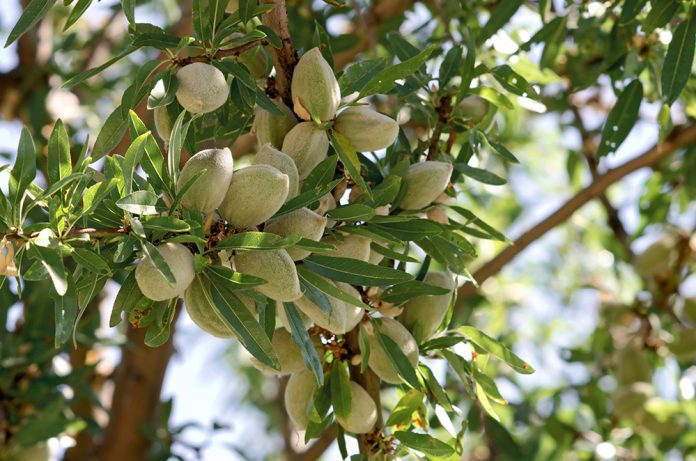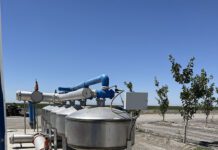Repurposing farm ground, temporarily or possibly permanently reducing use of groundwater for irrigation, is an effort that is still in preliminary stages. Jesse Roseman, Almond Board of California’s principal analyst for environmental and regulatory affairs, said impacts and locations where it will apply are not yet completely clear.
According to UC Merced, land repurposing is the practice of transitioning irrigated land to new uses that conserve water and deliver new benefits to communities or ecosystems. Potential benefits to land repurposing listed include restored habitat corridors, community recreation spaces, low-impact solar and groundwater recharge basins.
It is clear that lack of surface water supplies and increased regulation of groundwater extraction in many of the state’s subbasins will increase the chances that some irrigated farm ground in this state will come out of production. Estimates from the Public Policy Institute of California and the San Joaquin Valley Water Blueprint are that as much as one million acres of farm ground in the San Joaquin Valley could be removed from production. Roseman said this would have dramatic impacts on growers, local towns and cities, food supply and the state economy.
There is interest on both the state and local levels to make the impact tolerable, Roseman said, but he expects that demand reduction will be painful for the agriculture sector. Some of the reduction is drought-related, but some is due to Sustainable Groundwater Management Act compliance.
Roseman pointed out that as of early November, not a single management plan submitted by San Joaquin Valley groundwater sustainability agencies had been approved by California’s Department of Water Resources.
While repurposing could reduce groundwater pumping and overall demand, the state is also exploring new storage and conveyance projects that would improve water supplies long-term, limiting the need for demand reductions. California has also recently made an effort to streamline groundwater recharge projects that could be in place short-term, Roseman said, even for any available flows this winter.
SGMA Driving Efforts in Groundwater Management
SGMA, Roseman said, has highlighted the interdependence of groundwater basins in the Central Valley and it is driving efforts to address groundwater management. Regionally, he noted that creative solutions on supply and temporary demand reduction of agricultural water influence the direction of land repurposing efforts.
Land could be returned to production depending on the results of pilot projects and regional programs, which Roseman said are designed and developed with stakeholder input to fit the needs of individual basins.
“There is flexibility in land repurposing; it does not have to be permanent,” Roseman said.
There are voluntary funding program options available for growers who are facing water shortfall. These programs are aimed at addressing SGMA requirements, reducing land subsidence and supporting crop production in a smaller footprint.
Pilot Program
The California Department of Conservation’s Multibenefit Land Repurposing Program is one pilot program that growers of permanent crops could consider. The process for growers to receive funding through the MLRP has not been developed. This program is being developed for three pilot areas in the San Joaquin Valley. Initial funding will be available to growers located in the Greater Kaweah GSA, Pixley Irrigation District and Madera County GSA.
The Greater Kaweah GSA and Kaweah subbasin partners were awarded a $10 million grant to support development of tools for assessing and selection of multibenefit land repurposing activities. The partners will also develop a multibenefit land repurposing plan. The plan will include strategies suited for the region. Projects selected for implementation will be conducted on lands least viable for irrigated agriculture and that contribute to resource connectivity.
The Pixley Irrigation District GSA program is designed to facilitate strategic land retirement, restore habitat and protect water resources in the overdrafted Tule subbasin.
The Madera County GSA will build on a Sustainable Agricultural Lands Conservation program grant used to prioritize land to remain in agricultural use and land designated for fallowing. Plans will be based on recharge potential, soil quality and water supply. Funding from the MLRP will expand the plan regionally and explore designation of habitat restoration. Funds will also be directed to incentive payments to landowners to repurpose marginal ag land for multiple benefits and water savings. Land adjacent to rural communities could be used for buffer zones and pollinator habitat.
Other state and federal programs open to almond growers to capture funding include the USDA Farm Service Agency’s Conservation Reserve Program. These 10- to 15-year contracts are for establishment of resource-conserving plant species to remove environmentally sensitive land from production.
The American Farmland Trust Regional Conservation Partnership Program has funds in the San Joaquin Valley for ag easements and land rentals. Projects are ranked based on access to a reliable water supply. This program promotes coordination with the Natural Resources Conservation Service, which will fund conversion of ag land to floodplain habitat.
The California Department of Conservation Working Lands and Riparian Corridors Program offers watershed restoration grants.
More information on these programs can be found on the Almond Board of California website. Roseman said he sees possible opportunities in these programs for growers with permanent crops. Stakeholder input in these programs is important, he said, as they must fit the needs of the groundwater basin.
These programs are aimed at reducing water use, he said, and while they are still in the beginning stages of development, it is important for growers facing reduced water supplies to look at these programs as they may be a way to help with cash flow and the difficult decisions they are facing with reduced water supplies.
Roseman stressed that it will be an individual decision to participate in repurposing and conservation programs. These programs are voluntary, while compliance with SGMA is mandatory.
Growers of permanent crops will have their own set of challenges with shortfalls in water supplies, whether due to reductions in surface deliveries or restrictions on groundwater pumping. Roseman said with difficult decisions ahead for many growers, he advised looking carefully at these funding options while recognizing that decisions will be up to each operation. There may be more programs in the works that extend the time to pull out and replant orchards, aimed at short-term pumping reductions to help with basin stability, so it will be important to follow these programs and explore their usefulness to help maintain economic productivity.

Cecilia Parsons | Associate Editor
Cecilia Parsons has lived in the Central Valley community of Ducor since 1976, covering agriculture for numerous agricultural publications over the years. She has found and nurtured many wonderful and helpful contacts in the ag community, including the UCCE advisors, allowing for news coverage that focuses on the basics of food production.
She is always on the search for new ag topics that can help growers and processors in the San Joaquin Valley improve their bottom line.
In her free time, Cecilia rides her horse, Holly in ranch versatility shows and raises registered Shetland sheep which she exhibits at county and state fairs during the summer.
















